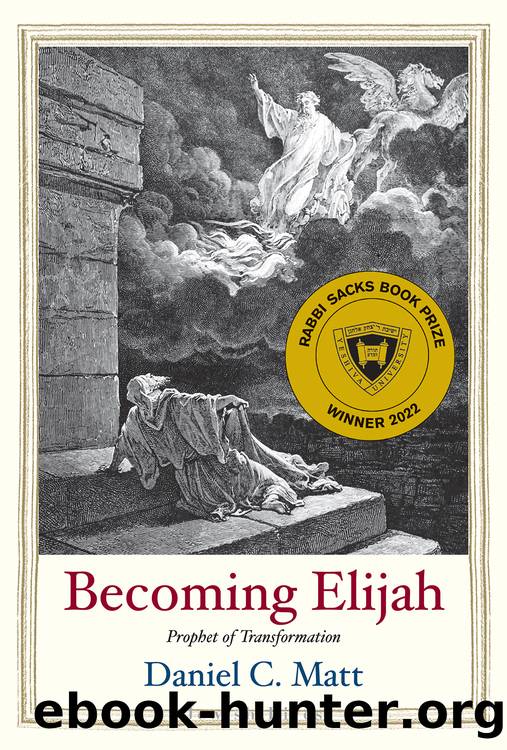Becoming Elijah by Daniel C. Matt

Author:Daniel C. Matt [Matt, Daniel C.]
Language: eng
Format: epub
ISBN: 9780300264920
Publisher: Yale University Press
Published: 2022-12-15T05:00:00+00:00
ELIJAH AND THE CARMELITES
Elijah became an inspiration for Christian spiritual seekers. Based on his portrayal in the book of Kings, he was reimagined as a religious hermit and the founder of monastic life. It seems strange to think of the fiery zealot Elijah as a humble monk, but he could be visualized as celibate, since he seems to have never married or had children. In his minimal dress, he also looked like a hermit: a hairy man, with a leather loincloth bound round his waist (2 Kings 1:8). One of the first things we hear about him is that after declaring the drought to King Ahab, he fled to the wadi of Cherith, where he lived alone for an extended time, surviving on water from the stream and on bread and meat delivered miraculously by ravens.17 Throughout his life, prayer was his instrument, enabling him to revive a lifeless boy, call down fire from heaven, and restore the rain. Soon afterward, he wandered into the desert and trekked for forty days to Mount Horeb, where he encountered God in a vibrant stillness.
Although the biblical Elijah often interacts with other peopleâfrom kings to an impoverished widow to the Israelite massesâChristian thinkers reasoned that he sought solitude as his way of life. In the words of a fourth-century author, âElijah was such a one who fled the tumult of human society and chose to live in the desert.â18
Perhaps he lived in a cave. The only cave mentioned in the Bible in connection with Elijah is the cave on Mount Horeb, where he spent the night before meeting God. But a tradition developed about âa cave of Elijahâ on another mountainâMount Carmel, where the Man of Truth defeated the false prophets of Baal, calling down fire from heaven to consume his sacrifice.19
Itâs unclear when a certain cave on the slopes of Mount Carmel was first called the Cave of Elijah, but that name likely appears before the sixth century in Toledot Yeshu (The Life of Jesus), a Jewish polemical satire on Christianity. In this narrative, predictably, Jesus loses to the rabbis in a contest of magical powers, and then he flies away to Elijahâs cave on Mount Carmel.20
Jews, Christians, and Muslims have all prayed in that caveâand still doâimagining that Elijah preceded them there. By the fifth century, individual Christian monks were dwelling on Carmel, perhaps meditating in Elijahâs cave, sensing his presence. Seven hundred years later, a group of crusader pilgrims from the West settled on the mountain as hermits, and they became known as the Carmelites. Long ago, some of them believed, Elijah had established a contemplative community there. Its members would have included âthe guild of prophets,â a brotherhood who appears in the book of Kings, interacting with Elijah, though primarily with his disciple, Elisha.21
Journeying through Palestine around 1170, the famous Jewish traveler Benjamin of Tudela describes what he saw on Carmel: âThere on the mountain is the Cave of Elijah (peace unto him), and there the Edomites [i.e., the Christians] have made a place of worship, which they call San Elias [Saint Elijah].
Download
This site does not store any files on its server. We only index and link to content provided by other sites. Please contact the content providers to delete copyright contents if any and email us, we'll remove relevant links or contents immediately.
The Five People You Meet in Heaven by Mitch Albom(3473)
The Secret Power of Speaking God's Word by Joyce Meyer(2968)
Real Sex by Lauren F. Winner(2966)
Name Book, The: Over 10,000 Names--Their Meanings, Origins, and Spiritual Significance by Astoria Dorothy(2938)
The Holy Spirit by Billy Graham(2892)
0041152001443424520 .pdf by Unknown(2783)
ESV Study Bible by Crossway(2732)
How The Mind Works by Steven Pinker(2728)
Ancient Worlds by Michael Scott(2622)
Churchill by Paul Johnson(2505)
The Meaning of the Library by unknow(2503)
The ESV Study Bible by Crossway Bibles(2502)
The Gnostic Gospels by Pagels Elaine(2468)
MOSES THE EGYPTIAN by Jan Assmann(2372)
Jesus by Paul Johnson(2309)
City of Stairs by Robert Jackson Bennett(2307)
The Complete Dead Sea Scrolls in English (7th Edition) (Penguin Classics) by Geza Vermes(2231)
Ancient Near Eastern Thought and the Old Testament by John H. Walton(2194)
The Nativity by Geza Vermes(2178)
